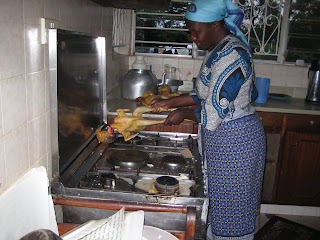









In each of the countries I've visited this year, I've tried to learn how to cook some of the dishes popular in the area. The cooking in this part of Kenya is based largely in vegetables, maize (the large kernel corn)and millet. Fish (particularly Tilapia) is also a staple here near the lake, and chicken and beef are sometimes added to the meals.
The chickens arrive live and are slaughtered, plucked and then defeathered before being stewed or fried. To those of us used to the plump chickens grown in the states, the first bite is a surprise; these are tough old birds, stringy and a challenge to chew, although flavorful.
The corn meal is made into a thick moist 'mush' called Ugali that is used to sop up the flavorful juices from the meat or vegetable dishes. It's a treat to watch the local folks tear off a hunk of ugali, shape it into a little cup and scoop up the sauces. They make it look easy, but when I try it, I get sauces all over my fingers.
On this evening, Carol Sande, one of the Slum Doctor staff, took Kathryn, Julie, Heather and me into the kitchen to teach us how to make
- Kachumbari; (a cold shredded salad of vegetables - carrots, tomato, cucumber, or whatever is handy) and lime juice
- Pilau; a rice dish spiced with dhana jeera, garahm masala and cumin
- Potatoes, peas & carrots spiced with chiles and mchuzi mix, a cornstarch & spice mixture - (coriander, cinnamon, fennel, tumeric, ginger, garlic, cumin & methee seeds) that seems to be put in almost every dish. The cooks call it by the brand name Royco.
The cooks tolerated us, often laughing about our preparation attempts, but the food ended up tasting delicious.

No comments:
Post a Comment